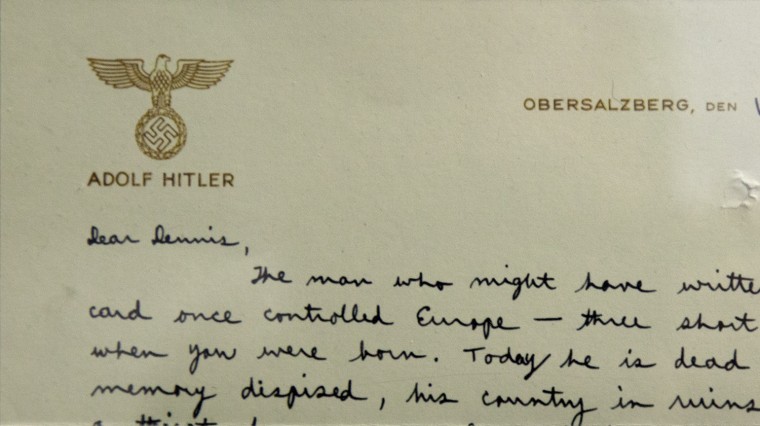
Inside a glass case in a “secret” CIA museum is a swastika-emblazoned letter written on Adolf Hitler’s personal stationery that was delivered to the museum the day after Osama bin Laden died.
The handwritten letter, sent by future CIA Director Richard Helms to his 3-year-old son at the close of World War II, may not be as ominous as bin Laden’s AK-47 featured in this exclusive NBC News report, which rests in another of the private museum’s display cases. But it too serves as both a trophy of war and a reminder of evil.
“Dear Dennis,” reads the letter from Helms, then a spy stationed in Germany. “The man who might have written on this card once controlled Europe – three short years ago when you were born. Today he is dead, his memory despised, his country in ruins. He had a thirst for power, a low opinion of man as an individual, and a fear of intellectual honesty. He was a force for evil in the world. His passing, his defeat – a boon for mankind. But thousands died that it might be so. The price for ridding society of bad is always high. Love, Daddy."
The letter was among a trove of memorabilia that Dennis sent to the museum 66 years later, in May 2011, to form part of an exhibit that pays tribute to the CIA’s roots in a wartime agency called the Office of Strategic Services, or the OSS.
The OSS wing of the CIA’s museum, which opened in 2011, traces the short history of an organization that was founded in 1942 to aid resistance fighters and run spies behind enemy lines before morphing into the CIA four years later. The exhibit includes counterfeit German postage stamps created by the OSS with a skull superimposed on Hitler's image, the desk of OSS director William "Wild Bill" Donovan, and all manner of secret weapons and messaging systems.
Among the exhibits is a tribute to Virginia Hall, an OSS agent who posed as a French farmhand as she counted German military units prior to D-Day. Hall, who had a wooden leg, organized sabotage and trained Resistance fighters. The Gestapo knew her as the “limping lady,” and called her the most dangerous of all Allied spies. She later became one of the CIA’s first female officers.
The Helms memorabilia in the museum also includes a piece of Hitler’s personal china, snatched from the Fuehrer’s Berlin chancellery, as well as other photos and correspondence. But the letter on Hitler's stationery, said curator Toni Hiley, is “truly a treasure in our collection."
Dennis Helms, now 71 and a lawyer in New Jersey, said he found the letter when he was a teenager in the late 1950s, while he was living with his parents in Virginia.
"My mother was an avid scrapbook keeper," said Helms. "And I was prowling through one of the scrapbooks and I found this. I asked about it. (I thought it) was really cool. But I had no idea there'd be so much interest in it later on."
Helms said the letter was very out of character for his dad, who, like many veterans of World War II, spoke little about his experiences during the war. The elder Helms, according to his son, was also guarded in general. He was CIA director from 1966 to 1973, during the Vietnam era, and was a controversial figure in American life. In 1977, he pleaded no contest to failing to testify fully to Congress about the CIA’s efforts to oust Chilean president Salvador Allende.
"He was very unguarded in this (letter),” said the younger Helms. “He actually gave his opinion of things. Later on, after years in the agency, everything was based on fact. He never varied from that ... That's what makes this so unusual to me."
There are a few questions about the circumstances under which the letter was written. Richard Helms, who died in 2002 at age 89, can’t answer them. The letter is dated “V-E day” – Victory in Europe day, which was May 8, 1945 – but the stationery says Obersalzberg, a town in the Bavarian Alps that was the site of Hitler’s mountaintop retreat, the Eagle’s Nest. Helms was among the first intelligence officers to visit the Eagle’s Nest, but according to his memoir he was in France on V-E day.
Hiley said the museum hasn’t been able to figure out where and when Helms wrote the letter, but prizes the document because of the message and the significance of the day it arrived at the museum.
"Look at the last sentence: 'The price for ridding society of bad is always high,'" Hiley said. "He couldn't imagine that the CIA would receive that letter some 66 years later. That we would receive it (right after) we, as well as you, heard that bin Laden was dead."
Related:
More from NBC News Investigations:
- Ex-supervisor at Indian point nuclear plant charged with falsifying test reports
- Obama nominee faces probe involving company run by Hillary Clinton's brother
- Report: Germany used key NSA surveillance program